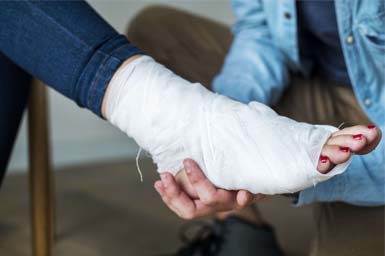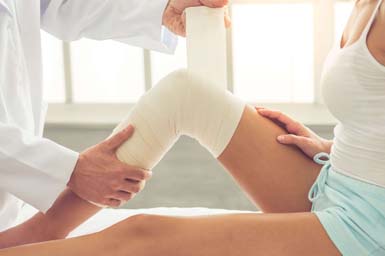The lower limb (also lower extremity), in human anatomy, refers to the leg, starting from the hip and ending at the toes. It includes three regions:
- The thigh is located between the hip and knee joints.
- The leg is located between the knee and ankle joints.
- The foot is located distal to the ankle.
Thus, lower limb recovery pertains to treating conditions of the leg. The injuries of the lower limb, like those of the upper limb, are diverse. Wounds and sprains are the most common injuries of a range of types. The types of wounds that can be treated at home with the Gauze Rolls or Pads found in the first aid kit in your home are the same for the upper and lower limbs.
Below we demonstrate how to dress the leg and discuss why Gauze Rolls or Pads are generally recommended.
How To Dress Your Leg with Gauze Rolls or Pads
The method of dressing a wound with gauze rolls or pads is the same for all along the leg except for wrapping the foot/ankle. Below, we have described the steps you would need to follow to dress your leg properly.


Place the sterile gauze pad over the wound, covering it completely. Using a gauze bandage roll might be better if the wound is too long to be covered by a singular pad. Secure with medical tape.
Dressing Leg Wounds with Gauze Rolls
For a leg injury, wrap around the leg in a spiral motion along the leg until the wound is covered. Every layer should cover one-third of the previous layer secure with tape, clip fasteners, or by tying a knot. Ensure the amount of compression is safe.
Since the foot/ankle has a much larger range of motion, the chance of the dressing being undone is higher. To make sure the dressing is secure, follow the steps below instead:
Step 1: Carefully clean, disinfect, and dry the wound before dressing. Hold the gauze roll in one hand and hold its loose end in the other. Put the loose end behind your toes and wrap around the foot in a spiral motion, slowly moving towards the ankle.
Step 2: After securely wrapping the foot, start to wrap around the ankle in a figure-of-eight pattern.
Step 3: Move toward the heel on the bottom and toward the calf at the top of the eight. Wrap the entire foot and end approximately three inches above the ankle.
Step 4: Secure the end with tape, clip fasteners, or by tying a knot. Ensure the amount of compression is safe. Check if the toes feel tingly/ numb or appear blue/purple as a sign of too much compression.

Why Use Gauze Rolls or Pads?
Gauze is the most common form of dressing and is a staple of every first-aid kit. It is frequently used for cleaning wounds, dressing injuries, prepping for surgery, and debriding contaminated wounds. But what is it that makes gauze such a popular choice? Let us take a look at the numerous benefits of Gauze Bandage Rolls or Sterile Gauze Pads that make them a suitable choice for such a diverse group of injuries.
- Comfortability: Cotton gauze is soft and breathable, making it comfortable for patients.
- Cost-effectiveness: Gauze dressings have been around for centuries and are often found to be the least expensive dressing method available, especially for injuries that are small or require less frequent dressing changes.
- Ease of use: The majority of healthcare professionals are familiar with the use of gauze since it is one of the oldest and most readily available materials. They are malleable and can be packed into areas that might be otherwise inaccessible like tunnels and sinus tracts.
- Versatility: Gauze Bandage Rolls or Sterile Gauze Pad dressings are available in many different shapes and sizes like rolls, strips, pads, etc. In addition to their variety in size, they can also be easily cut to fit the size needed. This makes them ideal for the treatment of all kinds of wounds, including small cuts, abrasions, wounds & minor burns, among others.
- Water absorption: Gauze products are highly absorbent making them ideal for cleaning wounds and stopping bleeding.
- Air Permeable: Gauze products are permeable and allow for ventilation to the wound which can help with healing.
- Anti-Allergic: A lot of gauze products are free from latex, lint, and other allergens, which makes them safe to be prescribed be used in close contact with the skin.
- Enhanced Healing: Proper dressing around the wound enables better and faster healing.
For the reasons mentioned above, gauze remains one of the most popular medical materials despite it being dated back to the ancient Egyptian civilization. It is important for people to be proactive about their healthcare concerns and basic first-aid care, so they can make informed choices. In a case of emergency, these seemingly simple practices may prove to be lifesaving.